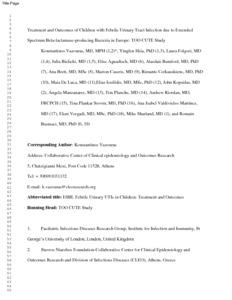Vazouras, K;
Hsia, Y;
Folgori, L;
Bielicki, J;
Aguadisch, E;
Bamford, A;
Brett, A;
Caseris, M;
Cerkauskiene, R;
De Luca, M;
et al.
Vazouras, K; Hsia, Y; Folgori, L; Bielicki, J; Aguadisch, E; Bamford, A; Brett, A; Caseris, M; Cerkauskiene, R; De Luca, M; Iosifidis, E; Kopsidas, J; Manzanares, Á; Planche, T; Riordan, A; Srovin, TP; Valdivielso Martinez, AI; Vergadi, E; Sharland, M; Basmaci, R
(2020)
Treatment and Outcomes of Children With Febrile Urinary Tract Infection Due to Extended Spectrum Beta-lactamase-producing Bacteria in Europe - TOO CUTE Study.
PEDIATRIC INFECTIOUS DISEASE JOURNAL, 39 (12).
pp. 1081-1087.
ISSN 0891-3668
https://doi.org/10.1097/INF.0000000000002838
SGUL Authors: Hsia, Yingfen
![[img]](https://openaccess.sgul.ac.uk/112162/1.hassmallThumbnailVersion/PIDJ-%20TOO%20CUTE%20accepted%20version.pdf)  Preview |
|
PDF
Accepted Version
Available under License ["licenses_description_publisher" not defined].
Download (2MB)
| Preview
|
Abstract
Background:
The prevalence of extended-spectrum beta-lactamase producing Εnterobacteriaceae (ESBL-PE) is increasing globally. ESBL-PE are an important cause of urinary tract infections (UTIs) in children. We aimed to characterize the clinical presentation, treatment and outcomes of childhood UTI caused by ESBL-PE in Europe.
Methods:
Multicenter retrospective cohort study. Children 0 to 18 years of age with fever, positive urinalysis and positive urine culture for an ESBL-PE uropathogen, seen in a participating hospital from January 2016 to July 2017, were included.
Main Outcome Measures:
Primary outcome measure: day of defervescence was compared between (1) initial microbiologically effective treatment (IET) versus initial microbiologically ineffective treatment (IIT) and (2) single initial antibiotic treatment versus combined initial antibiotic treatment. Secondary outcome measures: Clinical and microbiological failure of initial treatment.
Results:
We included 142 children from 14 hospitals in 8 countries. Sixty-one children had IET and 77 IIT. There was no statistical difference in time to defervescence for effective/ineffective groups (P = 0.722) and single/combination therapy groups (P = 0.574). Two out of 59 (3.4%) and 4/66 (6.1%) patients exhibited clinical failure during treatment (P = 0.683) when receiving IET or IIT, respectively. Eight of 51 (15.7%) receiving IET and 6/58 (10.3%) receiving IIT patients (P = 0.568) had recurring symptoms/signs suggestive of a UTI. Recurrence of a UTI occurred 15.5 days (interquartile range, 9.0–19.0) after the end of treatment.
Conclusions:
Time to defervescence and clinical failure did not differ between IET/IIT groups. Non-carbapenem beta-lactam antibiotics may be used for the empiric treatment of ESBL febrile UTIs, until susceptibility testing results become available.
| Item Type: |
Article
|
| Additional Information: |
This is a non-final version of an article published in final form in Vazouras, K; Hsia, Y; Folgori, L; Bielicki, J; Aguadisch, E; Bamford, A; Brett, A; Caseris, M; Cerkauskiene, R; De Luca, M; et al. (2020) Treatment and Outcomes of Children With Febrile Urinary Tract Infection Due to Extended Spectrum Beta-lactamase-producing Bacteria in Europe - TOO CUTE Study. PEDIATRIC INFECTIOUS DISEASE JOURNAL, 39 (12). pp. 1081-1087. |
| Keywords: |
Pediatrics, 1114 Paediatrics and Reproductive Medicine |
| SGUL Research Institute / Research Centre: |
Academic Structure > Infection and Immunity Research Institute (INII) |
| Journal or Publication Title: |
PEDIATRIC INFECTIOUS DISEASE JOURNAL |
| ISSN: |
0891-3668 |
| Dates: |
| Date | Event |
|---|
| December 2020 | Published | | 11 September 2020 | Published Online | | 24 May 2020 | Accepted |
|
| Publisher License: |
Publisher's own licence |
| URI: |
https://openaccess.sgul.ac.uk/id/eprint/112162 |
| Publisher's version: |
https://doi.org/10.1097/INF.0000000000002838 |
Statistics
Item downloaded times since 27 Jul 2020.
Actions (login required)
 |
Edit Item |


